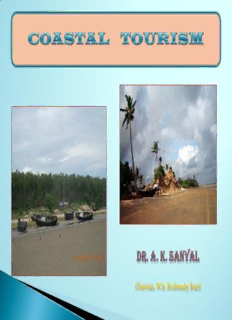
dr. ak sanyal PDF
Preview dr. ak sanyal
DR. A. K. SANYAL Chairman, W.B. Biodiversity Board Tourism is the largest and fastest-growing economic sector in the world. Globally, tourism and related economic activities generate 11% of Global Domestic Product, employ 200 million people, and transport nearly 700 million international travellers per year. These figures are expected to double by 2020, especially in some of the world’s least developed countrie. Global Tourism Tourism has expanded dramatically over the last 50 years and has become a global industry. According to WTO’s forecasts, long-distance travel worldwide will grow faster (5.4% each year) in the next decades than travel within regions (3.8%). WTO statistics for 2002 estimated international tourist receipts of US$ 463 billion, a total of 693 million tourist arrivals across the globe and forecast over one billion arrivals by 2010. European tourism accounts for 2/3 of global tourism and is expected to double by the year 2025. The Mediterranean is the World’s number one tourist destination and is generating 1/3 of global tourist revenues. Coastal areas are transitional areas between the land and sea characterized by a very high biodiversity and they include some of the richest and most fragile ecosystems on earth, like mangroves and coral reefs. At the same time, coasts are under very high population pressure due to rapid urbanization processes. More than half of today’s world population live in coastal areas (within 60 km from the sea) and this number is on the rise. Additionally, among all different parts of the planet, coastal areas are those which are most visited by tourists and in many coastal areas tourism presents the most important economic activity. Coastal areas are some of the most productive and biologically diverse on the planet. They're also the most densely populated: according to the UN, 60% of the world's population - more people than inhabited the entire planet in 1960 - live within 60km of the coast. On top of this, 80% of all tourism takes place in coastal areas, with beaches and coral reefs amongst the most popular destinations. An Overview of Tourism in Coastal Areas The origins of tourism in coastal areas go back to Roman times, when the first villas were constructed in the Southern part of the Apennine peninsula. In the centuries that followed, especially from the mid-18th century onwards, coastal tourism was generally related to the therapeutic properties of sea and sun. Sun, sea and sand have continued to provide the main ingredients for coastal tourism until today, especially in the second half of the 20th century, which was marked by the development of mass tourism. An Overview of Tourism in Coastal Areas Coastal tourism is based on a unique resource combination at the interface of land and sea offering amenities such as water, beaches, scenic beauty, rich terrestrial and marine biodiversity, diversified cultural and historic heritage, healthy food and good infrastructure. It includes a diversity of activities : development of tourism capacities (hotels, resorts, second homes, restaurants, etc.) and support infrastructure (ports, marinas, fishing and diving shops, and other facilities). An Overview of Tourism in Coastal Areas Besides physical conditions, the development of tourism in coastal areas is related to socio-economic features of the receiving environment such as local community interests, health and security conditions, political factors including unpredictable crises, exchange rate fluctuations, and traditional models of tourism exploitation or, simply, a successful or less effective marketing-led depiction of a destination. Environmental conditions such as unpredictable climate conditions, algae blooms, winds and the associated risk of forest fires, tsunami, storms and floods, as well as many other constant features or unexpected events, affect tourism development in coastal areas. An Overview of Tourism in Coastal Areas Coastal recreation activities, which have been increasing both in volume and in number during the last decade, occupy a unique place in coastal tourism. They take in two main types of recreational uses of coastal zones: Consumptive and non-consumptive ones. Activities such as fishing, shell fishing and shell collection, etc. belong in the first category while activities in the second include swimming, diving, boating, surfing, wind-surfing, jet skiing, bird watching,snorkelling, etc. An overview of tourism in coastal areas Coastal tourism is strongly dependent upon natural (climate, landscape, ecosystems) and cultural (historic and cultural heritage, arts and crafts, traditions, etc.) resources. It encompasses activities that can only be carried out in particular areas and in specific conditions. Therefore, certain areas are considered to be particularly suited to specific types of tourism activities, for which they became known on a global scale. Examples include sailing in the Gulf of Mexico, surfing on the beaches of Australia and Hawaii, or scuba diving in the Red Sea.
Description: